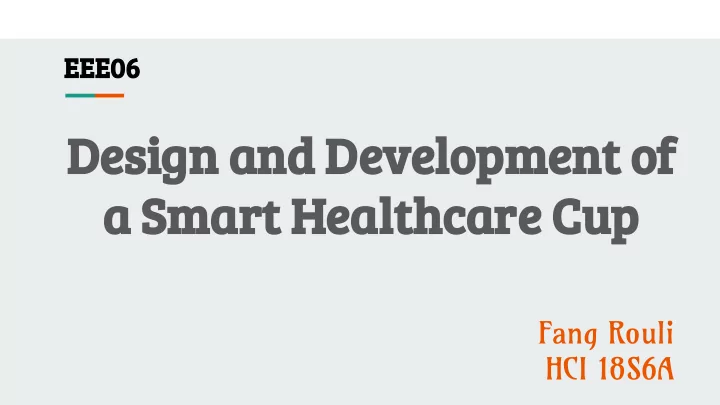

EEE06 Design and Development of a Smart Healthcare Cup Fang Rouli HCI 18S6A
Background Information
Background Information ● Smart devices have become necessary. ● There have been products monitoring liquid intake. ● However, they can only sense the temperature or record the volume of water.
Background Information ● Caffeinism & Alcoholism ● Caffeinism : headache, nervousness and insomnia ; serious health issues. ● Alcoholism : mental and physical health problems, even death.
Objective
● Counting water intake ● Counting caffeine intake ● Counting alcohol intake Aims ● Giving feedback on drinking & ● Setting medicine-taking Objectives reminder ● Not only for the caffeine or alcohol addictive , but also for common people who are concerned about this problem.
Materials
● Arduino UNO Board and USB cable ● MQ3 ethanol sensor Materials ● DS18B20 temperature sensor ● HY-SRF05 ultrasonic distance sensor ● Wires ● Breadboard ● Computer ( MAC OS)
Digital controller ● Arduino & ● Python 3.6 Code operator ● Microsoft Excel
Water counting Caffeine counting Design Temperature sensing Alcohol counting Feedback function Reminder function
Methodology Part I : Water Counting
Methodology - water counting ● HY-SRF05 ultrasonic distance sensor
Methodology - water counting Arduino code will take the time interval between the sending and receiving ultrasonic waves and calculate distance .
Methodology - water counting ● The effect of angle of reflection is neglected. ● Total volume of the cup is input manually at the start. ● The Python code will calculate the volume of liquid and store it into a text file. ● The shape of the cup is considered column.
Methodology Part II : Caffeine Counting
Methodology - caffeine counting ● As an organic solute, liquid chromatography is commonly used to detect the presence of caffeine. ● it is impossible to directly measure the amount of caffeine of the drink in the cup with present sensors, while still let the liquid in the cup edible. ● A code in the Python interface is set up for the cup.
Caffeine concentration in different type of drinks (Mayo Clinic)
Methodology - caffeine counting
Methodology Part III : Temperature Sensing
Methodology - temperature sensing ● DS18B20 temperature sensor ● Arduino code: take 5 readings with 0.1s time interval
Methodology - temperature sensing
● There is correlation between temperature, the concentration Hypotheses of alcohol in the liquid, and the concentration of alcohol in the air above the liquid.
Methodology Part IV : Alcohol Counting
Methodology - alcohol counting ● MQ3 ethanol sensor ● Experiment settings
Methodology - alcohol counting
Methodology - alcohol counting
Methodology - alcohol counting
Methodology - alcohol counting ● Experiment limitations: ○ Ratio of liquid volume against the cup’s volume is not included as a variable. ○ The time duration between pouring the liquid and taking measurement is not included as a variable. ○ The temperature range selected is small, reducing the reliability of the result.
Methodology Part V : Feedback Function
Methodology - feedback function ● Retrieve data stored in the text file ● Compare to actual standard of adult liquid intake (Mayo Clinic) ● Guide users to drink healthily Data Sample
Methodology Part VI : Reminder Function
Methodology - reminder function ● Time library ○ make time manipulatable ● Threading library ○ keep function running as other functions are called
Methodology - reminder function
Results Conclusion Future Work
Results & Conclusion ● Fully functioning smart device
Results & Conclusion ● Fully functioning smart device. ● Choice of sensors and accuracy of measurements are limited to reduce cost and unnecessary calculation. ● Emphasize on the ingredients in the liquid and giving apt guidance for users to drink healthily.
Future Improvements ● Add bluetooth function to be wireless. ● Downsize the hardware to make it more practical. ● Conduct more validation on the accuracy of the sensors, and more tests on how long they can keep working for. ● Transfer the program into mobile app in GUI ● Add function of sugar and calorie counting
Thank you for listening!
Recommend
More recommend